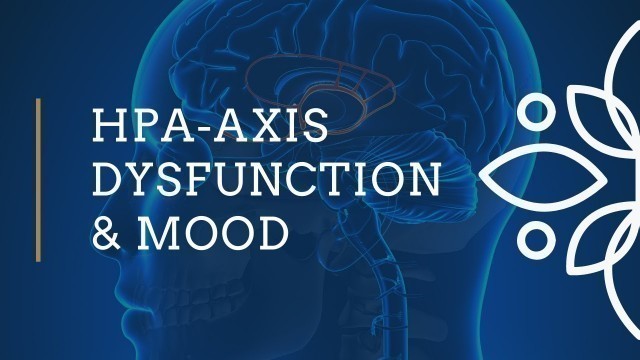

'HPA Axis Dysfunction & Mood | Exploring the Mind Body Connection #HPAAxis #dysregulation #cortisol #mentalhealthmatters #integrativehealth Want to chat with me 1 on 1? At https://members.docsnipes.com/ you can chat with me individually 7 days a week, access my members only blog and help me continue to create new videos for only $10/month. #HPAAxis #Dysregulation CEUs are available for this presentation at AllCEUs https://www.allceus.com/member/cart/index/product/id/1183/c/ Sponsored by TherapyNotes.com AllCEUs provides multimedia #counseloreducation and CEUs for LPCs, LMHCs, LMFTs and LCSWs as well as addiction counselor precertification training and continuing education. Live, Interactive Webinars ($5) Unlimited Counseling CEs for $59 – Hypothalamic-Pituitary-Adrenal Axis – Controls reactions to stress and regulates digestion, the immune system, mood and emotions, sexuality, and energy storage and expenditure – The signs and symptoms of HPA-Axis dysfunction reflect a persistent, abnormal adaptation of neurobiological systems to trauma or chronic stress. – In addition to trauma, multiple lifestyle factors have been associated with HPA-Axis dysregulation Consequences of HPA-Axis Dysfunction – More than 50% of Americans suffer from one or more chronic conditions associated with disturbances of the HPA-Axis with an estimated cost of $3.3 trillion annually including: Overview of Healthy HPA-Axis Function – When exposed to a physical, environmental or social stressor, the HPA-Axis is activated and prompts the “fight or flight” reaction. – Glutamate and Norepinephrine are released – The hypothalamus releases corticotropin releasing factor (CRF) and arginine vasopressin (AVP) to stimulate the anterior pituitary to produce and secrete adrenocorticotropic hormone (ACTH). – ACTH causes glucocorticoid (cortisol) synthesis and release from the adrenal glands – Cortisol’s primary function is to – Increase blood glucose and modify fat and protein metabolism to fuel the fight or flight reaction – Modulate immune and brain function to effectively manage stressors. – Cortisol initially causes a potent anti-inflammatory response which allows the organism to react to the stressor without being pain or fatigue. – Glucocorticoids interfere with the retrieval of traumatic memories – As cues of the threat wane, the body increases inflammation by releasing proinflammatory cytokines to accelerate wound healing Stress Response – The response of an individual to stress depends not only on stressor characteristics, but also on factors specific to the individual Emotional Valence – The NEVER (Negative Emotional Valence Enhances Recapitulation ) model of emotional valence, asserts that the greater the number of stimuli related to the unpleasant event that are remembered, the greater the likelihood that the person will encounter reminders of the event leading to increased recapituation. Physiological Changes Due to Hypocortisolism – Sustained HPA-Axis activation causes persistently high levels of CRH which eventually causes a blunting of the ACTH response to CRH stimulation – Disinhibition of corticotropin releasing hormone (CRH) and norepinephrine which lead to an exaggerated response to acute stressors and corresponding increase in cortisol. – Exposure to additional stressors produces stronger trauma-related symptoms in part due to the exaggerated HPA-Axis response causing the stressor to have a stronger negative emotional valence – Exaggerated elevation of cortisol during exposure to acute stressors increases the sensitivity of NMDA receptors, which makes the brain generally more vulnerable to excitoxic effects of stress – The volume of the hippocampus which controls not only the HPA-Axis and stress responses, but also declarative memory is reduced due to the excitotoxic environment. – Amygdala activity increases and promotes hypervigilance and impairs threat discrimination – Reduced prefrontal cortex volume impairs executive functioning and impulse control – Reduced anterior cingulate volume impairs the extinction of fear responses – Thyroid hormones become imbalanced leading to abnormal T3:T4 ratio and increases in anxiety – GABA (inhibitory) activity is decreased, and glutamate (excitatory) activity is increased – GABA has profound anxiolytic effects in part by inhibiting the CRH/NE circuits – Increased dopamine and norepinephrine levels increase arousal, startle response, fear memory encoding and increased HPA-Axis activation in response to recapitulation. – Changes to the ratios of estrogen, testosterone and progesterone occur which impact the body’s ability to modulate cortisol levels #DrDawnEliseSnipes provides Counseling CEUs and training through allceus'
Tags: depression , anxiety , online training , QUANTUM , Trauma , mental health matters , fatigue , lpc ceus , ce4less , HPCSA , fight or flight , podcast ceus , lcsw ceus , lmhc ceus , NAADAC ceus , LSW CEUs , addictions academy , counselor toolbox , neurobiology , ADACB , Dawn-Elise Snipes , Cheap CEUs , unlimited ceus , lcdc ceus , lmft ceus , LADC CEUs , Trauma INformed Care , ACA CPD , LCSW OPD , CADC CEUs , CAP CEUs , C4CSA , NetCE , CCMC CEUs , Addictions CEUs , Emotional Dysregulation , HPA Axis , neurobiological
See also:

















comments